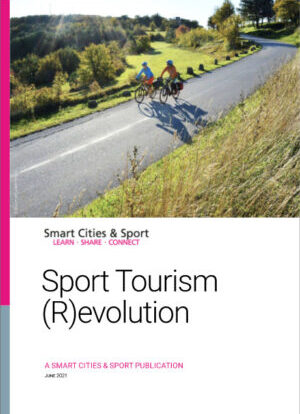events & legacy
Rugby World Cup 2019 in Japan: A tale of twelve cities

Share this post
The facilitation of major events across different cities can also benefit sport tourism. Indeed, this type of organisation allows tourists to go beyond a single host city and visit an entire country or at least several regions. This approach allows each host city to benefit from economic spin-offs, as opposed to a scenario where revenues are centralised in one location. In addition, multi-city events also enable host cities to develop and promote their brand image to tourists who might not otherwise travel to them. RWC 2019 in Japan offers a good illustration of the impact of multi-site sports events on tourism!
According to Paul Bush OBE, Director of Events at VisitScotland, “Co-hosting events across cities, regions or countries is an important trend for the future as it will allow for more sustainable impact by using existing infrastructure as well as developing those social and cultural benefits across a much greater geographical area.”
The Rugby World Cup is the flagship tournament for both men’s and women’s rugby and is typically staged in four-yearly cycles for teams who have passed specified qualification criteria. Since the inaugural tournament in 1987, Rugby World Cups have been held in Europe, North America, Africa and Oceania. The latest one – in Japan in 2019 – was the first time the event had ever been held in Asia.
The men’s tournament in Japan in was the most economically successful Rugby World Cup ever, with US $ 5.6 billion generated in economic output according to the Economic Impact of Rugby World Cup 2019 (RWC 2019) Report published by Ernst and Young.
The venues were spread across the country in a balanced manner between urban areas and regions, allowing the whole country to benefit from the event. Any hosted match becomes a major event in itself for the host city within a larger national event. More precisely, Japan 2019’s matches were conveniently spread across twelve stadia and 16 fan zones in twelve cities on three of the four main islands that make up Japan: Yokohama, Tokyo, Sapporo, Oita, Osaka, Kobe, Kumamoto, Fukuoka, Aichi, Iwate, Saitama and Shizuoka.
A winning bet on international tourism
Figures speak for themselves and prove how much the combination of sport events and tourism are a win-win proposition, as highlighted in the Ernst & Young Review of Outcomes:
- 242,000 international visitors from 178 nations staying an average of 17 days vs 14 days for RWC 2015
- 60 % of fans visiting Japan for the first time
- Tourists visited five cities on average
- 90 % of fans said they would return to Japan
- US $ 3 billion spent in Japan by international visitors
- Daily spend was 4.6 times higher than that spent by the average visitor to Japan in 2018
- US $ 375 average spend per international visitor per night, almost double compared to England 2015
The report also took a close look at what inbound spectators did while in the country. Results show that many inbound spectators travelled long distances around Japan following the matches of their national teams, which resulted in a trend towards longer stays. Moreover, four different types of tourists; each with different expectations were identified:
- ‘Activity lover’; i.e., people who actively sought out tourism opportunities in Japan such as: ‘drinking Sake’, or ‘bathing in hot springs’ – accounted for 38% of inbound spectators.
- ‘Culture explorer’; i.e., people who visited a number of regions and tried to encounter ordinary Japan – accounted for 28% of inbound spectators.
- ‘Tournament visitor’; i.e., people who wanted to stay and relax while they enjoyed the tournament – accounted for 19% of inbound spectators.
- ‘Typical tourist’; i.e., people who visited popular destinations for ordinary tourists – accounted for 15% of inbound spectators.
Beyond the tourism and economic impact, the social impact
Such a high level of national passion for a rugby competition is rather unprecedented in Japan. Nearly all Japanese people became ‘nikawas fans’, non-core fans attracted by the excellent results of the national team attaining the quarter finals of the tournament and by the atmosphere generated by a very well-organised event. A strong feeling of national pride emerged from the competition.
Academics looked at an interesting element of the 2019 RWC, namely the overall social impact of the event on Japanese residents, distinguishing between the expected social impact (pre-event) and the experienced social impact (post-event). The results indicate that emotional expectations played an important role in predicting viewer behaviour during the event. This confirms that the expected emotional benefits of sport inspire consumer behaviour.
At the city level, the RWC 2019 host cities developed interesting strategies for promoting their image through the event beyond tourism attractiveness; one example is the City of Higashi Osaka, in Osaka Prefecture. The latter developed its city, not only by renovating the football stadium, but also by developing the entire area around the stadium, including the park and the museum. It also set the stage for wheelchair sport, with the aim of attracting these events after the RWC.
The 2019 RWC is a successful example of a major sport event achieving short-term economic objectives and longer-term social benefits, a renewed image of the country and the host cities both abroad and internally, and combining soft and hard legacies.
To learn more
rugby world cup 2019 delivers record economic, social and sporting outcomes for japan.
rugby world up brought 30% more tourists to japan from participating countries, inquirer.net.
rugby world cup 2019 review of outcomes, ey japan 2020.
the economic impact of the rugby world cup 2019, ey japan 2020.


